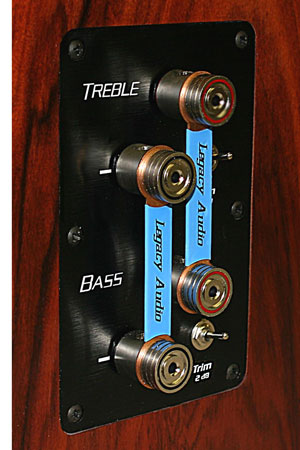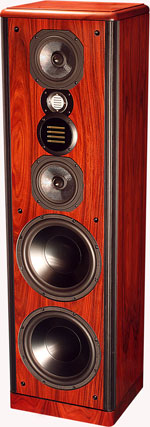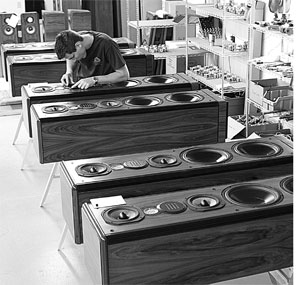 Becoming Legacy
Becoming Legacy
Established in 1983 by Bill Dudleston and his father in law, Jacob Albright, Legacy Audio began as an engineering-driven loudspeaker company with audiophile concerns. When Jake retired in 1997, Bill brought on the Allen Organ Company as a logical partner. For Allen was the world leader in digital organ technology, providing such niceties as anechoic facilities, a 30 year background in digital signal processing and a large elaborate woodshop.
In time, however, the marketing and R&D expectations didn’t line up (Allen Organ wanted to emphasize marketing, and Bill wanted to emphasize R&D), so after several years Bill purchased the company back as sole owner. It reaffirmed Legacy Audio as a high-end audio manufacturer, meaning that Bill could implement his designs fully and maintain his own quality control standards. Because of those years of lateral movement, Bill cut away six products from the lineup. In retrospect, the speaker designs that Bill developed emerged ultimately to become a blessing as Legacy’s newer offerings have made a quantum leap forward.
I had the pleasure of stopping by the Legacy factory more than once on my way to St. Louis to visit relatives, the factory is only three blocks from the freeway exit for Springfield, Illinois. On one occasion, I saw 9 pallets of Legacy’s finest speakers, namely the Whisper and Helix, being readied for departure to Russia and South Africa. The Allen Organ affair may have slowed down the inevitable; Legacy is beginning to make a name worldwide as a manufacturer of impeccable products.
The designer as well as the conditions under which designs are manufactured play an indisputable role in whether said products become worthy of being called “heirloom components.” That term in itself seems like an oxymoron when applied to electronics. Inasmuch as a component can be of heirloom quality, Legacy’s products fit the Bill (sorry, Mr. Dudleston, I couldn’t resist the pun)! They are dreamed up and manufactured here in the American heartland.
Bill has melded the heritage of fine furniture cabinetry inherited from Jake with his own technological prowess. One can visit the newly updated Legacy Audio website (www.legacyaudio.com) where Bill’s bio elucidates his string of patents for such technologies as Controlled Directivity loudspeaker designs, Wave-Launch Coherence in low frequency radiators, and Dynamic Braking in active speaker design, among others. It’s obvious the man has some smarts and skills when he’s designed Legacy speaker monitors for Arista, Sony and Univeral Music Group, as well as the Stradivari Violin Society. Further, Grammy award-winning producers such as Rick Rubin and mastering engineer Herb Powers have used his designs in producing artists like Johnny Cash, The Red Hot Chili Peppers, and Mariah Carey. Bill’s got something good going, and some serious names in music know it!
Initially, Bill had agreed to have me review the Whisper speakers, however after thoughtful deliberation, we turned our attention to the redesigned Focus HD, which has been in the Legacy lineup since 1992. I awaited the delivery of these gems as anxiously as a wife awaits a living room set. My wife may get excited about furniture, but I get excited about speakers with furniture grade finish!
Due to their mass, the two hulking boxes weighing right at 400 pounds arrived shrink-wrapped and strapped together on a shipping pallet. Generous foam end caps protected the suspended treasures inside. I would not recommend moving them alone, especially if you are taking them up or down stairs as the task is Herculean. Once freed from the packaging, they are manageable enough for one person, except when inserting spikes. As always, if you have any hesitation, get a second set of hands to help.
Focus HD
Tall as a small Big Ben clock and nearly as well appointed, the approximately 56 inches tall HD’s have a light grey removable grill cover. The enclosure of the Focus HD is a melding of two individual cabinets, the lower housing a passive subwoofer comprised of two twelve-inch drivers, and the upper the midrange tweeter compliment. The midranges and tweeters are acoustically isolated within their own internal cabinet. The bulk of the 185 pounds for each speaker comprises the bass drivers, internal bracing, and the internal cabinetry for isolating the upper portion of the speaker. The beautiful, thrice hand-rubbed real wood veneer and solid-wood trimmed cabinets (available in Natural Cherry, Rosewood and Black Oak), are meticulously finished. Black ribbed accents run along the vertical front edges of the speaker, serving to break the large visual field.
The narrow rectangular feet of the speaker seem to be the weakest link; wooden strips acting as footers are held by two screws, and they stress ever so slightly as the weight of the speaker is on them while moving it on thick carpeting (More on this in Manufacturer’s Comment. –Ed.). While they never loosened or fractured, my suggestion to Legacy would be to thicken them up and reinforce them a bit more. Granted, they are intended to be utilized on hardwood surfaces and positioning them on their integrated furniture discs would be less stressful on them. I saw no information in the manual on whether the wooden feet should be removed for installation on carpeting. I kept them attached, as moving these heavy speakers with spikes could result in devastating snags in the carpet.
As becoming as the HD appears, the real beauty is in its technology – it is the original Focus 20/20 taken to the next level. The speaker has been entirely reworked and virtually from solid-wood top plate to base. Gone is the 12-inch “midwoofer”, as well as the Kevlar 7-inch mids, the 4-inch ribbon super tweeter and the 1.25-inch dome tweeter. Yes, literally, none of the original drivers are used in the Focus HD; even the 12-inch woofers are new, supposedly offering double the linear displacement and a totally enclosed Neodymium motor.
The advancements in driver configuration are sequential with technological advancements. Bill has tried a lot of drivers over the years from manufacturers like Beyma, Eton, Audax, B&C, Fountek, Focal, Seas, Vifa, Peerless, Foster, Eminence and MISCO. You get the point; he didn’t just try three drivers and call it good enough. He’s voiced hundreds of samples, and the results testify to it.
In discussing the driver complement, Bill shares, “The upper accordion-pleated ribbon tweeter is a third generation influence of Oskar Heil.” As with all Legacy drivers, it is a proprietary house design, and then over 15% of Legacy’s own drivers are rejected as not meeting spec! Although more costly, it ensures the tightest quality control. Moving air is a priority for Bill, and he proudly points out that this little driver can move air at four times the volume velocity of a flat driver!
Moving down the face of the speaker, the 4” mid-ribbon operates below 8kHz and is phase-locked and time-aligned with the pleated tweeter. It has a Kapton (What’s next? Kryptonite?) diaphragm with “a vapor deposited leaf tracing.” The result is greater power handling than typical ribbons. The face plates of the two upper drivers overlap so as to make one think that Legacy made a mistake – “OOPS! We didn’t revise the cabinet!” Hardly; nary a blemish gets past these guys! The drivers were the best that could be found, but needed to be spaced close together to unify them and minimize comb filtering.
Let me state unequivocally that this is the most nuanced tweeter scheme I have heard in my listening room, and I am hearing more precision and personality from the HD’s top-end than any speaker used previously. They are fast, fast, fast, and precise, precise, precise!!!
The original, 20/20 version of the speaker had a very tricky top-end, the soft dome tweeter needing an additional compensation network to control a natural resonance in the vocal range. The planar-mid of the HD bypasses this issue entirely, and its lowered mass improves transient behavior (read speed!).
Let’s duck around the backside of the speaker for a moment.
On the 20/20 version we would have seen three attenuation switches, for treble, midrange and bass. On the HD model we see only two – treble and bass. What happened to the midrange attenuation? It’s no longer necessary because the performance of the planar mid is eminently smooth. Legacy has historically offered purchasers of the 20/20’s the option of adding resistor networks to ameliorate treble using several steps of attenuation. As a testimony to the positive nature of the upgraded neo-ribbon and planar mid combo, there has been silence from the field in this matter, “Since we have released the HD model we have not yet had a request to soften the treble.”
Bill won’t get a request from me either.

While we’re in the back, we feast our eyes on the terminal plate and the formidable binding posts, which attest to the high quality design. The two offset pairs of posts for bass and M/T are turned from solid brass, plated with silver, and finally topped off with nickel. The offset design allows for easier access for fingers as well as terminations. I found them to be ideal ergonomically. Because they are offset, I never had to worry about larger spades accidentally touching each other. Be aware that because they are spaced widely a dual banana plug cannot be used. Even the proprietary solid copper jumpers exude Legacy’s upper echelon build quality.
Coming back around to the front again, we focus on the mid-bass drivers, which are properly known as 7” Rohacell backed Silver-Graphite drivers. This cast frame driver is constructed with a neodymium magnetic slug under the front phase plug in order to improve transients (read speed!), reduce distortion and increase efficiency. Bill exudes, “This driver’s useable range extends over seven octaves!” This results in a reduction of in-line components in the crossover network, which in turn reduces power loss.
Recall, if you will, that Bill plows through dozens of drivers. One day he came across a sample of a new woven composite material comprised of graphite and metal fibers. Bill began experimenting and the resultant diaphragm, backed by a thin layer of Rohacell for added stiffness, became his new midrange. As Bill enthuses, “Low mass, and stiff as heck!”
Another critical aspect of the midrange is its “push/pull electro-dynamic motor.”
Use of the front neodymium slug (I love saying that!) prevents the cone from straying too far. It brings dynamic drivers one step closer to operating on a planar plane in terms of speed. There must be good feelings at Legacy about this Rohacell driver, since plans are in the works for a new 15” driver which will go into the LF Extreme subwoofer and top-of-the-line Helix. Having heard the Helix at the factory sound room, I can scarcely imagine how much better it can get! But, knowing Bill, with time things will get better, much better.
Because the silver graphite mid-bass drivers now extend deep enough to mesh sonically with the 12” bass drivers, the “mid-bass” driver of the model 20/20 has been dropped and a second dedicated 12” bass driver added. This is exquisitely good for bass-ophiles! It means better quality and much more palpable low end. How low? Try 16Hz! That’s subwoofer territory!
Maybe you can get a sense of why I’m excited about these speakers. Their top end reminds me of the finesse and speed of planars. The mid-bass drivers have the stiffness of Kevlar but the speed of planars. The bass drivers have more than double the surface area of most floor standing speakers under $10k. I have heard several well-respected speakers at that price point, and none comes close to the bottom-end generated by the HD’s. The power and presence of the HD’s bottom-end is such that it is one of very few floor standing speakers under $10k not to need a subwoofer’s help. In fact, Bill commented that sometimes owners emphasizing HT application connect the sub outs to the bass inputs of the HD’s! I can easily hear why!
Speaking of HT applications, I also procured a Silver Screen center channel from Bill for this review. I put it in place of my Magnepan MGW C and was rewarded with surround music and movie sound tracks being filled in extravagantly.
The Silver Screen is a sizable center at 27.5”x10”x10.5”, and weighing 42 pounds, it’s constructed with the same zeal as Legacy’s mains. It is a three-way, four-driver configuration – a pair of 7” silver graphite woofers, a similar 5.25” mid-woofer and the same 1” neo-ribbon tweeter. With a richly appointed cabinet in the tradition of the Focus, and a frequency response down to 38 Hz, it is nearly the equal of many smaller floor standing speakers! One certainly gets their money’s worth in design and performance with the Silver Screen! The driver complement dovetails with the higher-end speakers in the Legacy line. However, an even weightier center, the Marquis, is available.
The economical Magnepan had been doing a wonderful job, but when the Silver Screen was used, with its matching driver complement to the Focus HD, it filled a gaping sonic cavity left by the MGW C. The effect was so dramatic that I liken it to a solid blacktop highway of sound versus the Magnepan’s rode construction zone where in the middle has been placed gravel fill. The quality of the voices spoken or sung produced by the Silver Screen completely matched the midrange of the HD’s and completely solidified the acoustic front. I put on some Michael McDonald on SACD to compare center channels, and suffice to say that it wasn’t until the Silver Screen was installed that he sounded like he had soul when he sang Motown hits. His voice was woven into the song with the same sonic fabric as the backup singers and instrumentation coming from the HD’s. This was confirmation of the advice given to serious video and surround enthusiasts to match their surround and main speakers.
Returning to the topic of bass presence, I found the difference between the Focus HD and its more refined sibling, the Whisper, to be instructive.
Having heard the Whisper, with its four 15-inch woofers, at the factory sound room I noted that it only has a lower rated limit of 22Hz, a whole 6Hz less than the much more modestly priced Focus HD. I thought, “Why should a person pay for two extra woofers per speaker only to get 6Hz less bass? The answer lies in the kind of bass experienced. In a word, the Whisper produces more refined bass than the Focus. Bill explained nicely, “Focus HD is utilizing the floor and the room impedance to achieve its output. Whisper is allowed full excursion down to its free air resonant frequency of 22Hz… Focus HD is like bathing in bass, whereas Whisper HD is like showering. Whisper doesn’t wait for the bathtub (room) to fill. It comes and goes.” That means Whisper has greater attack due to its four woofers. Someday, I’ll have to try that… In the meantime, I am deliriously happy that the Focus HD is such an authentically full-range speaker to enjoy.
You don’t need a world of power to drive these speakers. At 96dB sensitive, they are agreeable to more modest amps. On the other hand, a very good case can be made for purchasing the HD’s first, then working on an upgrade in power. Every additional watt will be icing on the cake!
Why was this speaker named Focus?
(To be continued)
- (Page 1 of 1)

